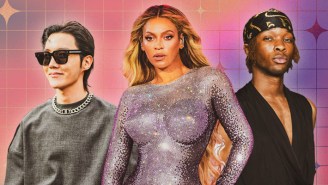Earlier this month, I read a story in Vice about group of NFT “investors” who had become the victims of a “rug pull.” According to the report, the developer of a planned game called “Evolved Apes” had taken the money investors thought would go to the project and instead simply vanished. The report went sort of viral, I assume partly on account of how absurd a picture it painted of the NFT world, and how hard NFTs are for the average person to understand.
As far as I can gather, the idea behind NFTs is that you can own a piece of digital art, like a digitized animation cel, its authenticity verified by the blockchain (somehow?), and that this is somehow an investing strategy. You pay for the digital art in the hopes that someone else later on will pay even more.
The idea for Evolved Apes then, was that this group of people would all own various NFTs, of these crude ape renderings. They would then pool their money to create a fighting game and some other multimedia projects involving those apes, and the games would, presumably, become more popular, causing the original NFTs to rise in value. For most people, I imagine this idea sounds both bafflingly inane and staggeringly idiotic, an attempt to somehow combine a Ponzi scheme with beanie babies and crypto. The weird idea at the center of it is that the tail can basically wag the dog; that one can begin with the individual, meaningless non-story elements of a story, and then simply create a story incorporating them, thus giving them value. Conceptually, it’s a bit like trying to make Looney Tunes as a pump-and-dump scheme for your rabbit drawing.
At some point during Marvel’s absurdly extravagant premiere for its new movie Eternals, which blocked off half of Hollywood Blvd, had police monitoring the crowd from rooftops and featured in-house Marvel “reporters” interviewing guests on the red carpet like it was The Oscars, I wondered if what I was experiencing was essentially just a massive-budget NFT scheme. Disney and Marvel own “Eternals,” a piece of IP (intellectual property) created by Jack Kirby in 1976, as part of their corporate assets ledger. On its own, the rights to a semi-obscure, 45-year-old comic book can’t be worth much. But what if Disney could create… an entire ecosystem of content… in which those Eternals drawings could… fly around and fight and stuff? Then they might be worth millions! Billions, even!
I know, I know, I’m supposed to be reviewing the movie, and not the spectacle of the premiere or the corporate strategy and blah blah blah. But in a roundabout way, I am reviewing Eternals the movie. To be sure, Eternals isn’t the first semi-obscure comic book property to be turned into a film. But it feels more than any before it like the tail trying to wag the dog, driven less by the ideas of its creators than the hopes of its investors.
Chloé Zhao directs, hot off her best picture-winning Nomadland, from a script written by Zhao, Patrick Burleigh, Ryan Firpo, and Kaz Firpo (a name with great mouthfeel, I shall never forget it). Disney has lately been the best in the business at both spotting and nurturing young talent, and Eternals production seemed like it was shaping up to be a case in point. Yet the film itself is a compellingly disjointed chimera that seems to move the goalposts of its own mythology every five minutes.
Eternals begins with a few paragraphs of prologue. “the Eternals,” we’re told, are a race of immortal humanoids, created by the same “Celestials” that created the universe. The Eternals’ purpose, then, is to defend Earth from the “Deviants,” a race of destructive predators who are always naysaying your investment strategies.
In the first sequence, the Eternal Sersi, played by Gemma Chan, has to save her human boyfriend Dane, played by Kit Harrington from Game Of Thrones, from a man-eating deviant, which basically looks like a stegosaurus made of CGI taffy. Sersi accomplishes this task using her power to transform inanimate objects into other inanimate objects (like a London bus into flower petals, or cobblestones into quicksand), and with the help of her teenage sidekick, Sprite (Lia McHugh), a shapeshifter and illusionist.
Dane manages to absorb all this, and the news that his girlfriend is an immortal 5,000-year-old alien fighter, with all the glibness of a Joss Whedon character ordering schwarma (he also apparently never questioned why his girlfriend’s bestie and roommate is a middle schooler). Almost immediately Dane has to ask why, if the Eternals have been protecting Earth all these years, they just stood back and let Thanos destroy half of all life in the universe a few years back (to say nothing of Hitler and Adam Levine and whatnot).
That Dane has apparently lived through Avengers: End Game along with us may partially explain his nonchalance about the supernatural. But the scene raises the much bigger philosophical question, of why the Avengers and Eternals should need to exist in the same fictional dimension at all. In two and a half plus hours, we never get closer to an answer. It just feels like corporate fashion. Someone somewhere simply decided that existing alongside The Avengers would make the Eternals more valuable, like dangling the possibility of a future merger to juice the stock. Is this for the viewers or the investors? Does Disney know the difference, or are they deliberately conflating the two?
The Eternals, it turns out, are led by Ajak, played by Salma Hayak, whose power is being able to communicate with a Celestial (a massive being with a mostly unintelligible basso voice who looks like a continent-sized version of The Iron Giant). Ajak in turn guides her team of Eternals, which includes Ikaris (pronounced “Icarus”), played by Richard Madden from Game Of Thrones, who can fly and shoot laser beams from his eyes, Kingo (Kumail Nanjiani) who shoots hand rockets, speedy Makkari (Lauren Ridloff), brainy (and gay!) Phastos (Brian Tyree Henry), psychoactive Druig (Barry Keoghan), super-strong Gilgamesh (Don Lee), and weapon-conjuring ‘Thena (Angelina Jolie). The rub of the first scene is that the Deviants they all thought were dead are back, and now they have to get the band back together in order to defeat them.
Unfortunately for Chloé Zhao and the writers of Eternals, we’ve all seen that movie, so it can’t just be that simple. Instead, and without spoiling anything, it turns out that the Eternals’ mission might not be so straightforward and noble after all. Their mission is driven by a guiding philosophy seemingly borrowed from Game Of Thrones (along with the Stark actors): What do we say to the God of death? Not today.
I always loved that line, and on a conceptual level, it’s kind of fun that Disney has made a film about heroes learning to defy God. Because, hey, maybe God is a remote micromanager trying to make decisions with no regard for conditions on the ground. In practice, this story is mind-bendingly convoluted and contradictory. Throughout it all, the Eternals team is constantly coming together and fracturing, factionalizing along various lines. They feud, fight, and fall in love with each other, complete with what I’m pretty sure is Marvel’s first depiction of two superheroes having sex on a beach. (Can Sersi transform the sand on their genitals into Gold Bond powder? Let’s explore this further).
Zhao and Co. do their best to individualize all these characters. Kingo has become a Bollywood star, Druig has gone Kurtz in the Amazon, Thena has some kind of remembering disease known as “Madweary” which makes her disassociate and try to kill the other Eternals from time to time, and Sprite is cursed to live out all eternity as a pre-pubescent tween, a la Kirsten Dunst’s character from Interview With The Vampire. Nanjiani, now buff for some reason (does shooting magic lightning bolts from your fingers really require muscle?) actually succeeds in squeezing laughs from the material a few times, but mostly the characters have so little room to breathe between rationalizing the ever-shifting plot that even Marvel’s normally successful formula for comedic insouciance doesn’t really work.
As in virtually all of these movies, the heroes must eventually come to the conclusion that humanity is worth saving, in spite of its faults — like the time they genocided the Aztecs or dropped nuclear bombs on Hiroshima (events referenced directly in Eternals). The odd thing is that Eternals has virtually zero human characters that might justify this view. None get more than a few minutes of screentime, such that the Eternals choosing to save them or not seems mostly a matter of demigod caprice.
It’s an open question of who the antagonist even is. Zhao and company will introduce an admirable level of moral complexity, only to snuff it out one or two scenes later for no apparent reason in what’s meant to be a rousing triumph. The action is not un-compelling, it’s just very, very weird.
It feels like they aren’t really trying to get us, the audience, to engage with any of these characters on a serious emotional level. They’re simply trying to build a massive playground in which these pieces of IP can continue to interact with one another accumulating maximum value. The narrative lengths to which the hired-gun creatives are forced to go to in order to accomplish this corporate mission are often comical and sporadically admirable, but what they haven’t done is create characters or a story that’s emotionally meaningful in any way.
Still, Eternals is hard not to recommend solely on the grounds that it’s so flailingly bizarre. It’s odd to a degree that’s impossible to convey without spoilers. I need you to see it so I know that I’m not hallucinating.
‘Eternals’ is available exclusively in theaters November 5th. Vince Mancini is on Twitter. You can access his archive of reviews here.







